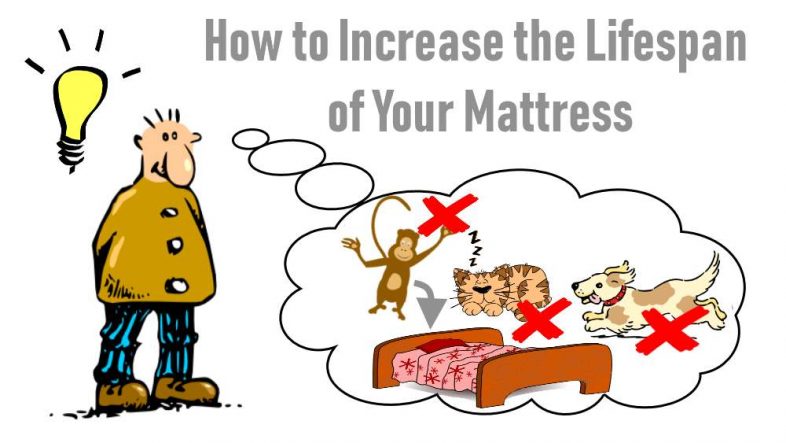Extending mattress lifespan and learning how to increase the lifespan of your mattress, is important on two levels. Firstly, every bit of saving from keeping a mattress for longer, helps to reduce the cost of living. Who doesn't want that! Second, the amount of waste produced by society can be reduced if every mattress lasts a little longer.

If millions of people all keep their beds clean and comfortable for a little longer, it soon adds-up to a really significant benefit for the environment.
Besides, is it really necessary to change a mattress as soon as the manufacturers suggest? Read-on to find out!
The article which now follows is written by Ellie Porter, today's Guest Poster:
How to Increase the Lifespan of Your Mattress
Did you know more than 50,000 mattresses end up in landfills every day? It’s a shame because 80% of a mattress is recyclable. One way to help your wallet and help to keep the planet healthy is to increase the useful lifespan of your mattress so you replace your bed less often.
In order from worst to best, here’s how long your mattress type should last, although it varies widely by bed manufacturer and quality:
- Innerspring mattress – 5 to 6-year lifespan
- Hybrid mattress – 5 to 6-year lifespan
- Memory foam mattress – 6 to 7-year lifespan
- Latex mattress – 7 to 10-year lifespan
Watch the video of this article, below:
Step 1 – Know your mattress
Every mattress is different. Materials and design dictate care and useful life. Is it flippable? If it is and you don’t, it can wear out faster. Most mattresses can be rotated head to foot every three months so long as the bed design is consistent from top to bottom.
But also, be sure to use a recommended bed base, that way you give yourself the best chance of delaying the day when your mattress is good for nothing except mattress disposal.
Step 2 – Maintain properly
Proper mattress care is easy but easy to neglect. Taking care of the bed can drastically improve lifespan. First, slap on a mattress protector and pad to protect from spills and basic wear. Second, wash sheets weekly, so you don’t have body funk leach into the bed. Third, air out the bed when you change sheets.
Step 3 – Protect from pets
Many people sleep with fur babies on the bed but allowing pets on your sleep surface wears it out faster. Consider getting them a pet bed. If you can’t sleep without your four-legged friend, put a thick towel or blanket on the bed and encourage them to sleep on that instead.
Step 4 – Keep it clean
Every four to six weeks. Strip the bed down completely and clean it. Vacuum off debris and use a lint roller to pick up more stubborn stuff. For a naturally clean, sprinkle with baking soda and spritz with lemon juice. Let it dry and thoroughly vacuum. There is no need to use harsh chemicals.
Step 5 – Don’t abuse your bed
Excessive wear and tear mean a shorter useful life. Try not to just let yourself go, and don't drop onto it. You'll tend to cause the edge to sag. Use your muscles to sit down, by lowering yourself gently. That will be better for your back as well.
Of course. Don’t ever jump on your bed (or let your kids). Try not to eat in it. Don’t let Fluffy sharpen her claws on it. And, if you spill, clean it up ASAP. (Also reduces dust mites.)
Mend any small rips or tears before they become ragged and spread.
Don’t buy the hype – replace only when required
The mattress industry promotes the slogan “replace every 8” to force a myth that you need to buy a new bed on a set schedule. You only need to replace it when it breaks down and has noticeable indentations, sunken spots, tears, or extruding springs. One way to prevent landfilling is to invest in a decent mattress and take good care of it.
If your mattress is near the end of its useful life, be sure to recycle it to a verified facility and don’t toss it in the landfill. When you buy your next mattress, look for one with proven longevity and properly maintain it.
Guest Post Author: Ellie Porter, Managing Editor | SleepHelp.org
The Average Lifespan of a Mattress
Earlier in this article, we gave a list of how long a mattress should last. In this section we will look at how long they actually remain in use, based on a Wikipedia article section:
By the term “mattress lifespan” we refer to the duration in which all types of mattresses can retain their original support and comfort. However, mattresses are expensive items and many people have other priorities in life other than having a perfect mattress.
Mattresses deteriorate over time, and the lifespan of a mattress depends on a variety of factors, notably materials, manufacturing quality, care, and the rigorousness of use.
A poor-quality foam comfort layer can deteriorate noticeably in 1 year, while a quality latex core can last 20 years or more; innerspring cores typically last around 10 years.
The comfort layer is almost invariably the first area to fail, which is why mattresses are often double-sided, to extend their lifespan. A separate topper may be used instead of or in addition to a comfort layer, which reduces wear and is replaceable without replacing the entire mattress. The majority of high-end mattresses have a lifespan of between 7–10 years but they can last beyond 10 years and more depending on the level of care.
United States Warranted Mattress Lifespans
In the United States, mattress warranties are typically for 10 years or 20 years, sometimes 25 years, though this specifically addresses manufacturing defects and faster-than-normal deterioration, not expected deterioration with time. In the United States, as of 2008, there is a general expectation that mattresses should last about 10 years, and this is the average number of years Americans keep mattresses, though this varies by age group.
This expectation is based on a number of factors, including sales pitches; the expectation that mattresses will last the length of their warranty, hence 10 years or 20 years, accordingly; and comparison with other household items.
Commercial Pressures Which Incline the Mattress Industry Toward Shorter Lifespans
The mattress replacement cycle is a key driver of income and profits for the mattress industry. A 5-year replacement cycle, yields double the sales of a 10-year replacement cycle, for instance.
So the mattress industry has a financial incentive to shorten the replacement cycle.
Notably, the International Sleep Products Association (ISPA) established the Better Sleep Council (BSC) in 1979 with the stated goal to:
“shorten the mattress replacement cycle”,
in addition to encouraging people to
“invest in better bedding”.
Mattress Lifetime Study Results
An industry-funded 2006 study of real mattress lifetimes, by researchers at Oklahoma State University (funded by the BSC) provided data.
Of 59 people with poor sleep who received free new replacement mattresses for their existing mattresses 5 years or older (average age 9.5 years) found improved sleep, particularly when the existing mattresses were cheap.
A follow-up paper by some of the same authors with additional statistical analysis reinforced these conclusions.
The BSC has subsequently cited this study in the ISPA-published news magazine for mattress manufacturers, BedTimes, to advocate a more frequent replacement cycle, specifically to “consider replacing a mattress every five to seven years”; the recommendation is based largely on this study. via Wikipedia.
Mattress Life – Our Verdict
Our view of the mattress lifetime study report is as follows:
- We note that improved sleep is seen when mattresses were replaced after just 5 years and this was found most strongly to apply to cheap mattresses.
- We have not seen a detailed breakdown of the report, but it would seem logical that buying a more expensive branded mattress is important for the longevity of mattresses.
Here at the Wastersblog, our focus is always on sustainability. Halving the lifespan of a mattress might raise the profits for the manufacturers and sellers, but the increased burden on planetary resources of this would be huge.
If you are concerned at all about quality of life in the future, we would encourage you to spend on quality and on mattress longevity all the time. OK. It is good to recycle your mattress if you possibly can.
But, the most sustainable option is without a doubt to go for a quality mattress with a long warranted life, despite the initial higher cost outlay.
If possible:
- extend the comfortable use of your mattress by using a mattress topper should the top surface lose its comfort
- avoid innerspring mattresses in general
- use a longer-life foam mattress, and maybe also consider buying a firm mattress for longevity.
The good news is that the quality mattress you buy will be more comfortable than the economy model, from day 1!
First published on 30 August 2018. Updated 13 February 2020.







The suggestions are given for augmenting the life span of a mattress are quite informational and impressive.